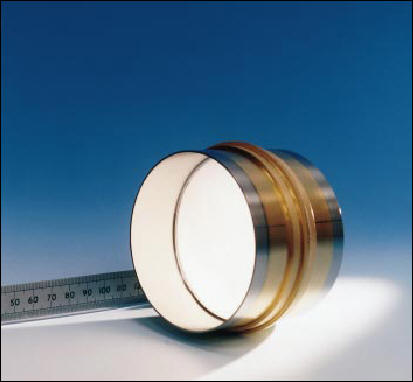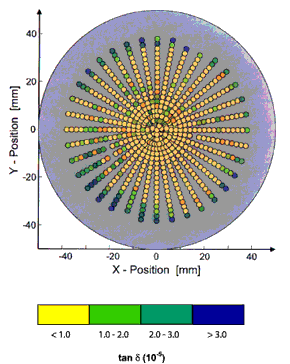| |
|
 |
 |
 |
|
|
 |
Microwave Windows |
|
|
|
|
|
|
|
Dielectric
Properties and
Applications
Low dielectric loss
materials find
application as the
output windows of
high-power microwave
tubes. A specific
case is that of
windows for Gyrotron
tubes operating in
the 70 to 170 GHz
frequency region
with output powers
in excess of 1 MW.
A specific
requirement in this
application is that
the window needs to
be approx. 100 mm
(4") in diameter,
1.6 mm to 2.3 mm
(0.063" to 0.091")
thick, depending on
microwave frequency,
and that the loss
should be relatively
uniform over the
area of the window
to avoid hot spots.
Results of
|
|
 |
|
a finite element
calculation of the
temperature rise at
the centre of a CVD
diamond traversed by
a 1.2 MW beam for
different values of
dielectric loss show
that thermal runaway
is oberserved for
losses above tan
d
= 2 x 10-4.
This is due to the
decrease of the
thermal conductivity
of diamond with
temperature. For
values of loss below
tan
d = 10-4,
the temperature rise
is less than 240 °C
for a simply water
cooled edge, which
is acceptable for
diamond.
|
|
At microwave
frequencies in the
range 72 to 145 GHz,
the absorption of
radiation in low
loss samples is
usually measured as
the decrease in the
Q factor of a
resonant cavity and
expressed in terms
of the tangent of a
loss angle
d.
During recent years
much attention has
been focused on
improving the
dielectric
properties of CVD
diamond in the mm
wave band.
Measurement of these
properties is
typically made at
145 GHz on samples
of material at least
30 mm (1.18") in
diameter and in
excess of 0.85 mm
(0.034") thick,
depending on
frequency. While
samples prior to
1997 had a
dielectric loss
tangent (tan
d)
in the range 100
-1000 x 10-6
recent
material has shown
that tan
d
in the range < 10 -
1000 x 10-6
can routinely be
achieved. The
following table
summarizes the
properties of a
dielectric grade of
Diafilm supplied
commercially in
sizes up to 120 mm
diameter x 2.25 mm
thick.
|
| |
Maximum |
Typical |
|
Loss
tangent,
tan
d
(x 10-6
) |
100 |
20 - 50 |
|
Equivalent
absorption
(cm-1
) |
0.007 |
0.0014 -
0.0035 |
|
Relative
permittivity,
er |
|
5.68 |
|
Data
measured
at
f=145
GHz
(l
=
2.1
mm) |
|
|
The right graph
shows the dielectric
loss profile of a
100 mm (4") window,
1.6 mm (0.063")
thick measured with
a scanning open
cavity resonant
system with a
spatial resolution
of 6 mm (0.24"). It
can be seen from
this graphic that
values of tan
d below 10-5
(close to or
below the
sensitivity of the
equipment used for
these measurements)
are possible and
that the material is
uniform over the
active aperture of
the window.
The predicted
temperature
excursion in a
window such as that
shown for a 1.2 MW
beam is less than 15
°C, and therefore
this material is
potentially suitable
for Gyrotron tubes
of powers well in
excess of 1 MW. This
places CVD diamond
as the only material
capable of running
continuous wave at
powers in excess of
500 kW without
resorting to exotic
cryo-cooling systems
as is the case with
sapphire. |

*Courtesy of R.
Heidiger, R. Spoerl,
Forschungszentrum
Karlsruhe |
|
In this section
 Standard Diamond
Windows
Standard Diamond
Windows
 Mounted Diamond
Windows
Mounted Diamond
Windows |
|
|
|
|
|